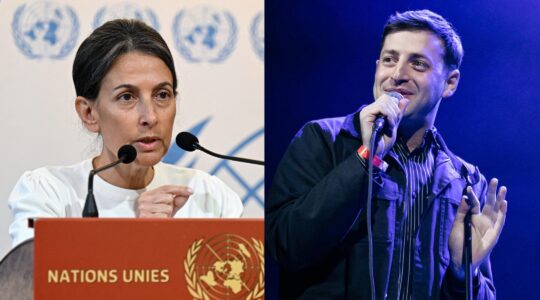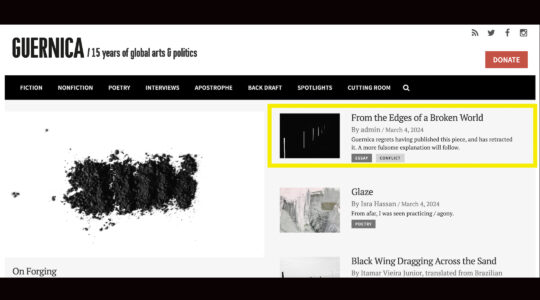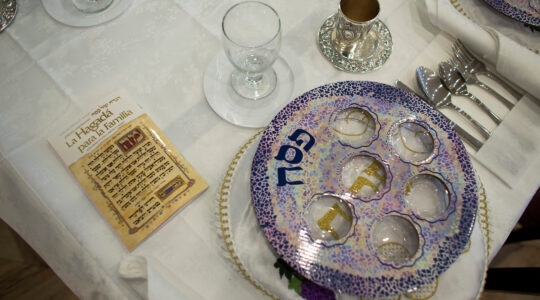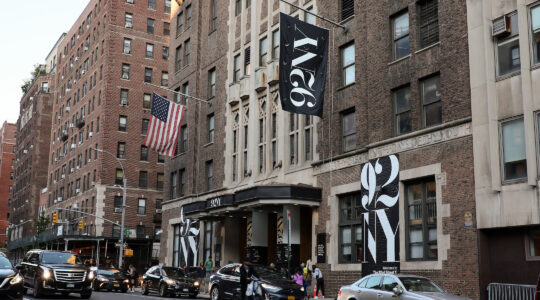PARIS (JTA) – Alexander Halaunbrenner easily finds his two kid sisters,
Mina and Claudine, in a group photo taken in an improvised summer camp
called Izieu near Lyon in 1944.The children hidden at Izieu were rounded up by the Lyon Gestapo led by
Klaus Barbie on April 13, 1944. Mina and Claudine were gassed at
Auschwitz along with more than 30 other children from the summer camp.The photo is among thousands of photographs, official documents, lists
and personal testimonies that make up the exhibit on deported children
at the Paris City Hall.Halaunbrenner’s father and brother were killed by Barbie’s Gestapo in Lyon. A baby
sister and his mother survived separately in hiding. Halaunbrenner was with
his mother.”It
breaks my heart every time I tell the stories of my family and the
Shoah,” said Halaunbrenner, now 75, as he surveys the large rooms at
City Hall filled by the exhibit.In all, 11,400 French children were deported, 6,000 from Paris.Halaunbrenner
has been the flag bearer for the past 35 years at ceremonies held by
the Association of Sons and Daughters of Jews Deported from France, which organized the City
Hall exhibit. The organization was founded and is still headed by famed
Nazi hunter Serge Klarsfeld.”I have been an activist for all
these years to teach young people that it really did happen,”
Halaunbrenner said. “The Gestapo called me in to identify my father’s
body. I was 10 years old. What can I say?”He looks around at
the crowd of people invited to opening day of the exhibit, nearly all
of them are elderly. They examine the photos and documents, and compare
family notes and train convoy numbers from the Drancy internment camp
north of Paris to Auschwitz.”Are the children and grandchildren
of all these people going to continue passing the message about the
Shoah to the French, the Europeans and the Americans?” Halaunbrenner
asks. “Frankly, the answer for the most part is no. People have other
things to do. They have lives to live.”Klarsfeld, well known in
Europe for tracking down Nazi war criminals including Barbie, the
so-called “Butcher of Lyon,” says school groups have signed up to visit
the exhibit.On Jewish radio here, Klarsfeld was asked about
bringing Jewish school groups to the exhibit, and says of course they
should come. “But the most important thing is to bring groups
of French French and Magrebi Arab French kids,” he said. “If they don’t
come and see the physical proof of the Shoah, they will stop believing
that it happened. In fact, that is happening already.”Klarsfeld sent an invitation to the Iranian embassy.”It
is obvious that Iranian President Ahmadinejad never took a class on the
Shoah,” he said wryly. “I would like to bring this exhibit to Iran, but
I don’t think that will happen.”The thousands of documents list
deportees city by city, and by district in Paris. It will be the
permanent collection of a museum on the site of the Des Milles
internment camp near Marseilles.”You notice that the children
are all dressed up in the photos,” Halaunbrenner said. “The photos come
from family archives. Neither the parents, children or the
photographers could imagine that these beautiful families would all be
killed not long after.”Photos show Halaunbrenner’s mother with
Klarsfeld’s wife, Beate, in La Paz, Bolivia. They traveled to Lima,
Peru, and then La Paz to identify Barbie, whom the Klarsfelds had
tracked there living under the alias Klaus Altmann.Originally
documented in Klarsfeld’s 1985 “Les Enfants d’Izieu,” or “The Children
of Izieu: A Human Tragedy,” the story now covers the walls of Paris
City Hall.Barbie was brought back to France in February 1982,
but his trial didn’t start until five years later. Halaunbrenner’s
mother was among the many who testified against Barbie in a trial that
made international headlines. Barbie died in prison in 1991.Barbie
had been recruited by U.S. counterintelligence services in 1947 in
Germany, and moved to Bolivia a few years later with U.S. government
help.Michal Gans visited the exhibit from Kibbutz Beit Lohamei
Haghetaot in Israel, where she is the international department director
of the Ghetto Fighters Museum.Gans is proposing a project to
French Talmud Torah classes and Jewish schools for parents holding
their children’s b’nai mitzvah in Israel.”We associate the bar
mitzvah with the memory and name of a child who was deported in a
ceremony that takes place at the museum,” she explained, noting that
several such ceremonies have taken place.She brings 30 high
school teachers to the Ghetto Fighters Museum every year from France,
Italy and Belgium. So far, 250 teachers have done the weeklong program
on the kibbutz.”We had a similar program in the States, but it
ended many years ago,” Gans said. “The key to teaching lessons from the
Shoah is in getting middle school and high school students to come to
exhibits like this one here in Paris.”Gallic French and Arab
and African French kids must come with school groups to see the photos
and documents. Otherwise they will never be able to believe what they
learn in class, if they learn anything at all.”
Holocaust exhibit in France a vital lesson
Advertisement





